
After watering our straw bales for three days our next step is to apply a high nitrogen fertilizer. We’re following West Virginia University Extension Service’s Straw Bale Gardening advice. They suggest a 1/2 cup of urea per bale or “bone meal, fish meal, or compost for a more organic approach.” (I think they mean blood meal as bone meal does not have much nitrogen in it.)
Choosing the organic approach, we’re watering in two cups of blood meal a day to each bale for days four to six. Days seven through nine, we’ll cut back to one cup of blood meal per bale. By day ten the bales should be almost ready to plant.
Once the bales are conditioned I’ll need to add a balanced organic fertilizer to provide potassium and phosphorous. And I discovered that taking the time to level the bales prevents fertilizer from running off when you’re trying to water it in.
Fertilizer Issues
Buying a high nitrogen fertilizer, even an organic one, is a bit of a conundrum. I object to chemical fertilizers, like urea, on philosophical grounds, but blood meal, a byproduct of our industrial food system, doesn’t make me feel much better. Urea would be a lot cheaper.
Perhaps the best solution would be human urine. Throw a week-long party, serve a lot of beer and invite your guests to fertilize your bales! Undiluted human urine has an NPK ratio close to that of blood meal.
Those of you who have experimented with straw bale gardens please leave a comment on what fertilizers you used and how it worked . . .
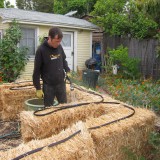
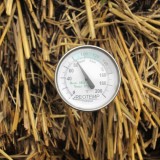
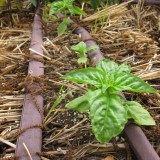
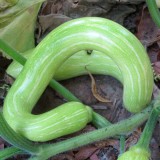
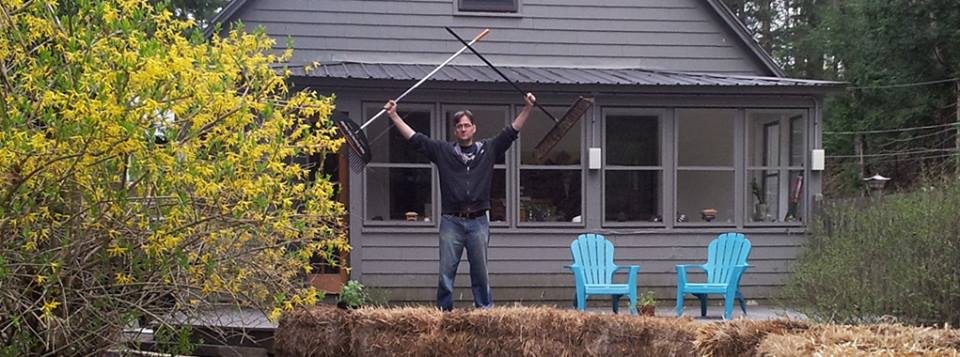
Do you mind sharing a link to where you buy your bloodmeal? You must buy it a lot cheaper than I was able to find it at the home improvement stores. If I were pouring that much on each bale the fertilizer bill on this deal would be $40 or more
Jake–I got it at Sunset Nursery in Silver Lake. It’s $30 for a 15 pound bag.
new blog name “Pee on the root, simple”
I’m learning a lot from these posts, and have something to keep my husband busy now in the evenings!
I’m totally in favor of diverting the human waste products into the garden bed. I regularly and consistently put mine into my compost pile. I once did a calculation and realized that by doing that, I had saved enough water by not flushing to fill a swimming pool (which I don’t have). The ‘feel good’ points on that alone were good enough to continue for the past several years.
On another front, the idea that we produce waste is the real problem. Nature doesn’t create waste. The byproducts of one process serve as the building products of another. We cannot be so species-bigotted that we only think that one life form has value. The bacteria that do the real work in the composting process thrive on the ‘waste’ products of other species. And we, in turn, thrive on the byproducts of those bacteria via the compost that feeds our plants in our gardens.
Using what we have available is a natural method, and is at the heart of the very concept of sustainability.
So go ahead, pee away!
Really enjoying your series on hay bale gardening. I assume this is a project you can start any time of the year (I live in So Cal), correct?
doh, straw!
I have the same disability. It’s all hay to me!
Yes, in SoCal we can garden year round, so you could theoretically start your bales any time. But ideally, I wouldn’t try to establish new plants in the dog days of summer (you’d be watering constantly) or around the winter solstice, when there’s just not much daylight. Established plants can cruise through these extremes, as long as they are heat or cold tolerant, respectively. So I guess I’m really giving you a qualified yes. If you can’t start your bales right now, I’d wait until the end of the summer and plant a fall/winter garden.
I started a straw bale garden to follow along with you. I noticed in the picture for this post that the straw at the top of your bales has the sides of the straw showing, as opposed to the ends of the straw pointing up. I have 4 bales with the end of the straw pointing up and 2 bales with the sides of the straw at the top. It seems like the ones with the ends pointing up stay wetter than the ones with straw sides on top. Is one direction better than the other or does it not matter?
Yes, the ones with the ends pointing up work better, but I’ve read that you can make both work. I could not find any bales at the place I get them that had ends pointing up. Please let me know how your garden works out–I’m interested in collecting anecdotes on this method of gardening.
Anecdotes? Sounds like the makings of a helpful book.
I found you a urine supply.
http://news.yahoo.com/blogs/sideshow/300-gallons-urine-found-inside-man-home-224127138.html
I was all set to link to that article, but you beat me to it! 🙂
We too started some bales along with you guys. I’ve been wanting to try it for a while, and you provided some helpful inspiration!
We’ve been watering for 3 days and are going to start adding amendments tomorrow. I couldn’t bear to use urea, or the blood meal, so we went with bat guano. Another step up in pricey-ness compared to the blood meal…and not as high in nitrogen. So we’ll see how that goes…
By the way – how did you make the conversion from 1/2C urea to 2C of blood meal?
One thing to consider with bat guano is the effect that harvesting it has on cave ecology.
Jeff Gilman over at Garden Professors has written about this a few times. https://sharepoint.cahnrs.wsu.edu/blogs/urbanhort/archive/2011/02/17/guano.aspx is one of those pieces.
Pretty much all the fertilizer options that you can buy have their downsides. So this isn’t necessarily an argument against bat guano, but it has made me think twice about using it.
Greetings,
I’m in the U.P. of Mich. I used straw bales last year for the first time. I watered the bales for several days, added dried chicken manure, working it into the straw. I let it sit for three to four weeks, stuck my hand inside to test for heat. Before i planted, i added compost on top. I had a nice little garden.
This was really our first garden here so far north. I’m not using this method this year, though. I had a lot of slugs, (beer worked), and a lot of mushrooms. It all canted to one side at one point and had to be shored up. The bales were all butted up to each other. (We have a tiny, tiny lot.) I’m going to use the basic principles outlined and apply it to a more traditional garden this year.
I have a bunch of alfalfa meal if you want to use that to add additional nitrogen.
Hey Robert–thanks for the offer, but I think I’m ok in the fertilizer department. Would like an excuse to see you again, though.
I sent you an invite on Facebook to a BBQ / meet & greet for Mitch O’Farrell, CD13 candidate. Might that be an opportunity?
Coffee grounds are fairly high nitrogen. At 2%, it’s not as high as blood meal or urea; but since WVU also says you can use compost, I would assume coffee grounds would be fine. In addition, your local coffee shop will probably give you their used grounds for free (I know Starbucks will, but other stores may have different policies.
hi there. i had great success using urine on my straw bales. i collected me and husband’s pee in a bucket next to the toilet covered with a tea towel for discretion. i applied 2 cups per bale every other day for the first 8 days then cut back to 1/2 a cup daily for 3 days. diluted in hot water from the kitchen faucet. my bales were at 140F by about day 5-6. amazing! by far the best organic source of nitrogen and it’s free and easily accessible. and really nothing gross about it at all.
Thrilled to see that you were successful using urine. You say you diluted it. What was the ratio you used of urine to water or did you use 2 cups of urine and added water? Did you water it all in or just applied the urine? Would love to know the details. Thanks!
I’ve got to get Erik to reply to this because the straw bale garden was really his baby, and the urine was his, too! He often was just peeing on the bales. There’s no need to dilute urine when it’s just going on the bales–as opposed to applying it to plants, where it should definitely be diluted. As to how much he was “applying” we’ll have to ask him. To be clear, we were also using blood meal as a nitrogen source.
Did you use the blood meal on the bales prior to planting or after?
Urine is about 4-0-0 in nutrient content. It also has a lot of salt, so beware.
When you posted the urine analysis 4-0-0, this means that there is 4 actual # of N in 100# of urine. Seriously that is like 2.5ea 5 gallon buckets of straight urine for 4 # of the good stuff. Is that actually what you were trying to say? I am curious about this notion and if so, how can I collect and store and keep in suspension. I am curious what the % salt would be. That salt number will greatly effect the ph.
I’m going off memory from a composting book. Maybe it was Rodale or something else. My library is in boxes right now, so I apologize. Anyhow, the 4% N value is for fresh urine, and the text probably meant to say that this is for darker urine. I would assume that clear piss is going to have less stuff in it, and the stinky urine that’s been waiting in the commode (or mason jar, lol) will not have as much nitrogen. Microbes burn it off fast if you don’t bury it in compost/straw.
Also, check this out; page 12!
http://www.melica.se/pdf/PhD_thesis_Zsofia_Ganrot.pdf
And this: http://modernfarmer.com/2014/01/human-pee-proven-fertilizer-future/
Did you have any trouble with the bales attracting mice for nests or insects or snakes etc.